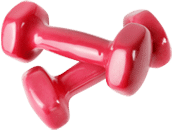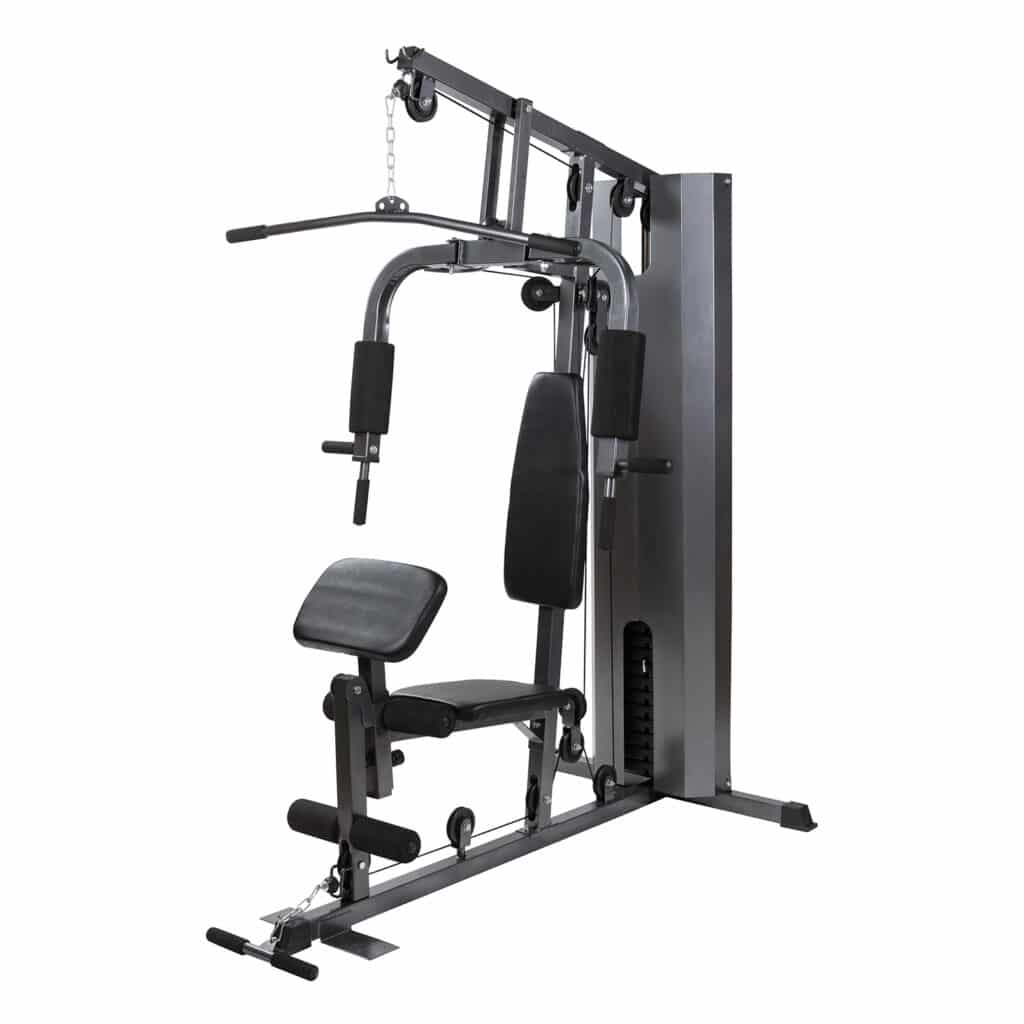
Resistance Training
What is Resistance Training?
Resistance training is a type of exercise that improves the strength of the muscles in your body. Resistance training is done by lifting weights (also called dumbbells), using your body weight for resistance, or using exercise bands.
Doing these exercises 2 to 3 times each week can increase your strength and endurance, and builds up your muscle.
What are the Benefits of Resistance Training?
As you get older, your muscles change and you lose almost one third of your muscle. This loss in muscle lowers your strength. Resistance training slows your muscle loss and builds your strength. Doing these exercises regularly can help you feel better and stronger.
Resistance training also helps you manage your diabetes. Every time a muscle moves, it uses the sugar that is in your blood. The more muscle you have on your body, the more sugar you use from your blood.
Getting Started Safely
Safety Alert
Do you have any of these health issues?
Talk to your doctor before you start a resistance training program, if you have any of the health issues below:
- untreated high blood pressure
- abdominal or inguinal hernias that have not been repaired
- untreated glaucoma
- eye complications from diabetes (retinopathy)
- muscle or joint problems (shoulder, back, knee)
- difficulty getting up from the floor
Your exercise team can make changes to your resistance training program to ensure you are safe.
Everyone can do resistance training. It is never too late to start. Below are tips to ensure you are safe when you are doing these exercises:
- Warm-up before resistance training and cool-down after resistance training. Try walking comfortably for 5 to 10 minutes as your warm-up and cool-down.
- Do dynamic stretches before you start your resistance training routine.
- Do all exercises in the order prescribed.
- Take at least a 30 to 60 second rest between exercises.
- Use proper technique for each exercise. Talk to your exercise team to make sure you are doing your exercises properly.
- Do each exercise slowly and breathe normally. Do not hold your breath – this increases your blood pressure.
- Lift the weight to a count of 2 and lower the weight to a count of 3. Going slowly will help you avoid getting hurt.
- Keep your Rating of Perceived Exertion (RPE) between 11 (fairly light effort, strain, or discomfort) and 16 (a solid hard effort, strain, or discomfort) to improve your health without getting hurt.
| RPE Score | Amount of Effort |
|---|---|
| 11 | Fairly light |
| 12 | |
| 13 | Somewhat hard |
| 14 | |
| 15 | Hard |
| 16 |
Borg, G. (1970) Perceived Exertion as an indicator of somatic stress. Scandinavian Journal of Rehabilitation Medicine, 2 (2), p. 92-98
- Do static stretches after you cool-down. Stretching may help improve your flexibility.
- Take at least one rest day between resistance training sessions. Rest will prevent injuries and allow your muscles to recover before the next session.
- Stop your exercise if you feel:
- signs of low blood sugar
- chest discomfort
- dizzy
- short of breath
- muscle or joint soreness
- Track your progress in an exercise diary. Your exercise team will review your exercise diary and help you progress your resistance training program.
Muscle Soreness with Resistance Training
After resistance training, it is normal for your muscles to feel sore and stiff. Soreness and stiffness happens many hours after you exercise and can last up to 4 days. Talk to your exercise team if you are sore and stiff for more than 4 days.
Muscle soreness happens because of very small tears that occur within your muscle. You may feel sore when you first start resistance training, try a new exercise, or increase the weight you lift.
Wait until all soreness and stiffness is gone before trying the exercises again. Giving your muscles time to heal will allow you to make the most gains in strength.
Resistance Training Equipment
There are many types of equipment you can use for resistance training. Examples include dumbbells (also called free weights), resistance training machines, and exercise bands. Talk to your exercise team about the type that works best for you.

Dumbbells (also known as free weights) are common pieces of resistance training equipment. Dumbbells are made of different materials including rubber, cast iron, and plastic.
Dumbbells can come as a fixed weight in one solid piece. They can also come as adjustable weights, with a solid bar that you add weighted plates to.

Resistance training machines are large pieces of equipment that are usually found in a gym. Training machines use a weight and pulley system to give you resistance.
You can buy these machines for home use.

Exercise bands are large elastic bands used for resistance training. Exercise bands are a good choice if you do not have room for equipment. They are also easy to take with you if you travel.
The colour of your exercise band tells you how much resistance it has.
Resistance Training Programs
Safety Alert
Stop and talk to your doctor or exercise team if you have any signs such as pain or shortness of breath when doing exercise.
Talk to your exercise team if you are sore and stiff for more than 4 days.
There are 3 different resistance training programs you can try:
- Mini-Resistance Training Program. This program has 5 core exercises to get you started on resistance training.
See the mini-resistance training program » - Standard Resistance Training Program. This program has 10 exercises that will use the major muscle groups of the body from head to toe. The standard resistance training program uses a combination of your own body weight, dumbbells, and exercise bands for resistance.
See the standard resistance training program » - Exercise Band Program. This program has 10 exercises that will use the major muscle groups of the body from head to toe. The exercise band program uses your own body weight and exercise bands for resistance.
See the exercise band program »
Resistance training and aerobic exercise are both part of your exercise program. Doing both types of exercise help you make the most gains in your fitness.
Do resistance training 2 times each week. This is the lowest number of times needed for you to gain benefit.
If you enjoy resistance training, you can do it every other day, which is 3 times per week.
Leave at least one day of rest between each resistance training session. This allows your body time to rest and repair your muscles between each exercise session.
To start resistance training, try 1 set of 10 repetitions for each exercise. For example, perform the bicep curl 10 times. To know if you are using the correct weight or exercise band for each exercise, answer three questions:
- After doing the last repetition, do you feel that you can do 5 to 10 more repetitions?
If you answer yes, the weight or exercise band is too light or too easy - Are you struggling to do the last repetition?
If you answer yes, the weight or exercise band is too heavy or too hard - After the last repetition, do you feel as if you could do 2 to 3 more repetitions and no more?
If you answer yes, this is a good starting weight or exercise band to use
Start with 1 circuit of the exercise routine (a circuit includes all the exercises in your program). Complete each exercise in the entire routine once before doing a second set.
The intensity of resistance training differs for everyone. Keep your RPE between 11 (fairly light effort, strain and/ or discomfort) and 16 (a solid hard effort, strain and/ or discomfort).
There are three factors that impact the intensity of your resistance training program:
- The amount of weight you lift or the amount of resistance from an exercise band. The heavier the dumbbell or more resistance from the band, the higher the intensity.
- The number of times you perform an exercise. The number of times you perform an exercise is called repetitions. The more repetitions you do, the higher the intensity. For example:
- 1 bicep curl = 1 repetition
- 2 bicep curls = 2 repetitions
- 3 bicep curls = 3 repetitions
- The number of times you repeat 10 repetitions. The number of times you repeat your repetitions is called a set. A set of repetitions is done with a break in between. The more sets you do, the higher the intensity. For example, do 2 sets of 10 bicep curls with a break in between.
Resistance Training Exercises
What are reps and sets?
A repetition (also called a ‘rep’) is one complete motion of an exercise.
A set is a group of repetitions done without stopping.
The exercises in your resistance training program will work all of your major muscle groups including:
- upper back muscles
- upper arm (front and back)
- shoulder muscles
- chest muscles
- stomach muscles
- upper thigh muscles (front and back)
- calf muscles
The type of exercise you do will depend on the equipment you will be using. Talk to your doctor before you start an exercise program.
How to Do Your Routine
- Walk slowly for 5 minutes as a warm-up before you start training.
- Perform the exercises slowly and breathe normally. Lift the weight while counting to 2 and lower the weight to a count of 3.
- Stretch after you finish training.
- Do resistance training 2 to 3 times each week, with at least one day of rest in between workouts.
- Take a 30 to 60 second rest between sets.
- Stop exercise for the day if you get any symptoms (such as angina, irregular heartbeats, feeling dizzy, shortness of breath, or muscle or joint pain).
Progress Your Resistance Training Program
Your body will adapt to each exercise over time. Progress your resistance training to ensure your body is still working hard enough to gain all the benefits of resistance training.
Progress Your Program Safely
When you progress your program, remember that
- not all exercises progress at the same rate
- not all muscle groups will be ready to progress at the same time
- not all muscles use the same weight
- When you are ready, slowly increase the number of repetitions you do from 10 to 15.
- Once you can do 15 repetitions with ease,
- increase the weight you lift by 2 to 5 pounds,
or
- change your exercise band for one that has more resistance.
- increase the weight you lift by 2 to 5 pounds,
Use the chart below to help you select the next weight or band colour.
Progressing Dumbbell Weights
Follow the order below to progress your dumbbells. For example, if you can do 15 repetitions with a 3 lbs weight with ease, try the 5 lbs weight next time.
Lightest
Heaviest
| 1 lb | 2 lbs | 3 lbs | 5 lbs | 8 lbs | 10 lbs | 12 lbs | 15 lbs | 20 lbs | 25 lbs | 30 lbs | 35 lbs | 40 lbs |
Progressing Exercise Bands
Follow the order below to progress your exercise bands. For example, if you can do 15 repetitions with a yellow band with ease, try the red band next time.
Lightest
Heaviest
| Yellow | Red | Green | Blue | Black |
Once you can do 1 set for each exercise with ease, increase to 2 sets for each exercise. This can take 2 to 3 weeks.
Do not do more than 2 sets.